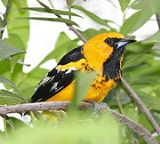
White-edged Oriole
Encyclopedia
The White-edged Oriole (Icterus graceannae) is a species of bird
in the Icteridae family. It is found in Ecuador
and Peru
.
Its natural habitat
s are subtropical or tropical dry forest
s and subtropical or tropical moist lowland forests. It is primarily a canopy dweller.
.
Bird
Birds are feathered, winged, bipedal, endothermic , egg-laying, vertebrate animals. Around 10,000 living species and 188 families makes them the most speciose class of tetrapod vertebrates. They inhabit ecosystems across the globe, from the Arctic to the Antarctic. Extant birds range in size from...
in the Icteridae family. It is found in Ecuador
Ecuador
Ecuador , officially the Republic of Ecuador is a representative democratic republic in South America, bordered by Colombia on the north, Peru on the east and south, and by the Pacific Ocean to the west. It is one of only two countries in South America, along with Chile, that do not have a border...
and Peru
Peru
Peru , officially the Republic of Peru , is a country in western South America. It is bordered on the north by Ecuador and Colombia, on the east by Brazil, on the southeast by Bolivia, on the south by Chile, and on the west by the Pacific Ocean....
.
Its natural habitat
Habitat
* Habitat , a place where a species lives and grows*Human habitat, a place where humans live, work or play** Space habitat, a space station intended as a permanent settlement...
s are subtropical or tropical dry forest
Forest
A forest, also referred to as a wood or the woods, is an area with a high density of trees. As with cities, depending where you are in the world, what is considered a forest may vary significantly in size and have various classification according to how and what of the forest is composed...
s and subtropical or tropical moist lowland forests. It is primarily a canopy dweller.
Conservation status
Due to its reasonably broad distribution and the diversity of its suitable habitat, most experts consider the threat of significant population decline to be minimal. The global population sizes and population changes have yet to be quantitatively measured. The species remains listed as Least Concern by Birdlife InternationalBirdLife International
BirdLife International is a global Partnership of conservation organisations that strives to conserve birds, their habitats and global biodiversity, working with people towards sustainability in the use of natural resources...
.

